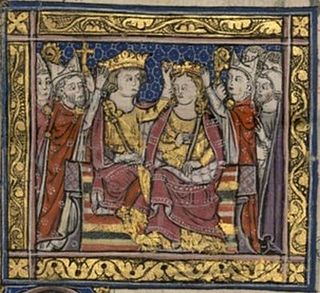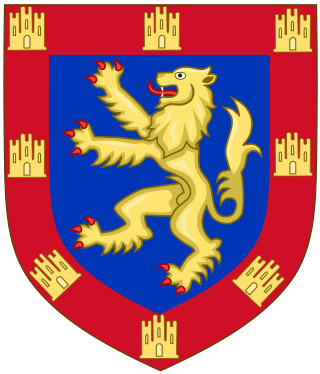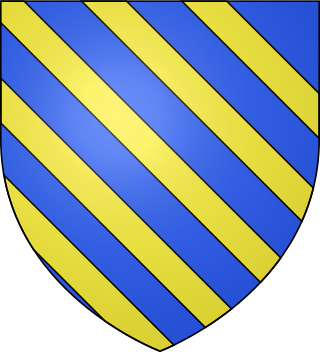Related Research Articles

Baldwin II, also known as Baldwin of Courtenay, was the last Latin Emperor ruling from Constantinople.

Peter, also Peter II of Courtenay, was emperor of the Latin Empire of Constantinople from 1216 to 1217.

John of Brienne, also known as John I, was King of Jerusalem from 1210 to 1225 and Latin Emperor of Constantinople from 1229 to 1237. He was the youngest son of Erard II of Brienne, a wealthy nobleman in Champagne. John, originally destined for an ecclesiastical career, became a knight and owned small estates in Champagne around 1200. After the death of his brother, Walter III, he ruled the County of Brienne on behalf of his minor nephew Walter IV.

Margaret, often called Margaret of Constantinople, ruled as Countess of Flanders during 1244–1278 and Countess of Hainaut during 1244–1253 and 1257–1280. She was the younger daughter of Baldwin IX, Count of Flanders and Hainaut, and Marie of Champagne.

Alfonso of Brienne, called Alphonse d'Acre, was the son of John of Brienne and Berengaria of León, born in Acre.

John I of Brienne was the son of Alphonso of Brienne and Marie de Lusigan. His mother was the heiress of Eu, Seine-Maritime, and he succeeded his father as Count of Eu in 1260.

The House of Courtenay is a medieval noble house, with branches in France, England and the Holy Land. One branch of the Courtenays became a royal house of the Capetian dynasty, cousins of the Bourbons and the Valois, and achieved the title of Latin Emperor of Constantinople.
Hervé IV of Donzy was a French nobleman and participant in the Fifth Crusade. By marriage in 1200 to Mahaut de Courtenay (1188–1257), daughter of Peter II of Courtenay, he became Count of Nevers.
The Duchy of Philippopolis was a short-lived duchy of the Latin Empire founded after the collapse and partition of the Byzantine Empire by the Fourth Crusade in 1204. It included the city of Philippopolis and the surrounding region.
Berengaria of León was the third wife but only empress consort of John of Brienne, Latin Emperor of Constantinople. She was a daughter of Alfonso IX of León and Berengaria of Castile. She was a younger sister of Ferdinand III of Castile and Alfonso of Molina.

Marie of Brienne was Latin Empress as the wife of Baldwin II of Courtenay. She served as regent during the absence of Baldwin II twice: in 1237–1239, and in 1243–1257.
Erard II of Brienne was count of Brienne from 1161 to 1191, and a French general during the Third Crusade, most notably at the Siege of Acre. He was the son of Gautier II, count of Brienne, and Humbeline Baudemont, daughter of Andrew, lord of Baudemont and Agnes of Braine. His paternal grandparents were Erard I, Count of Brienne and Alix de Roucy. During this siege he saw his brother André of Brienne die on 4 October 1189, before being killed himself on 8 February 1191. Erard II's nephew was Erard of Brienne-Ramerupt.
Jeanne, Dame de Chateaudun was a French heiress and the wife of two French noblemen: Jean I de Montfort and John II of Brienne, Grand Butler of France.

The Capetian House of Courtenay, also known simply as the House of Courtenay, was a royal house and cadet branch of the Capetian dynasty. Founded by Peter I of Courtenay, a son of King Louis VI of France, the family drew its name from the lordship of Courtenay, to which Peter's wife was heiress.
Matthew I was lord of Montmorency, Marly, Conflans-Sainte-Honorine and Attichy. He was also Constable of France from 1138 to 1160 under Louis VII.
Baldwin of Avesnes was a son of Bouchard IV of Avesnes and his wife, Margaret II of Flanders. His parents' marriage was later declared illegal, because his father had already received minor orders. Baldwin was later declared legitimate by the pope, at the instigation of King Louis IX of France. In 1246, Baldwin received Beaumont as an apanage.

William II, Lord of Béthune, nicknamed William the Red was French nobleman. He was a ruling Lord of Béthune, Richebourg and Warneton, as well as hereditary advocatus of the Abbey of St. Vaast, near Arras.
Anseau de Cayeux or Anselm de Cayeux was a French knight from Picardy, who participated in the Fourth Crusade (1202-1204) and later became one of the leading nobles of the Latin Empire, serving as regent in Constantinople (1237-1238). He was married to Byzantine princess Eudokia Laskarina, younger daughter of former emperor Theodore I Laskaris.
John of Valenciennes was a baron and diplomat of the kingdom of Jerusalem. He began in the service of the Latin emperor Baldwin II, before joining Louis IX of France on the Seventh Crusade. He was the lord of Haifa by marriage from 1257 until 1265. On behalf of the kingdom of Jerusalem, he led a major fundraising effort in Europe in 1261–1264. He served Louis IX as a diplomat to Mamluk Egypt (1250–1251), England (1264), the Papacy (1266) and Sicily (1267).
References
- 1 2 3 4 Perry 2018, p. 78.
- 1 2 3 4 Lock 1995, p. 63.
- 1 2 3 Perry 2018, p. 79.
- ↑ Perry 2018, pp. 80, 113.
- ↑ Perry 2018, p. 113.
- ↑ Perry 2018, p. 81.
- 1 2 3 4 5 Perry 2018, p. xxiii.
- 1 2 Pollock 2015, p. 190-191.